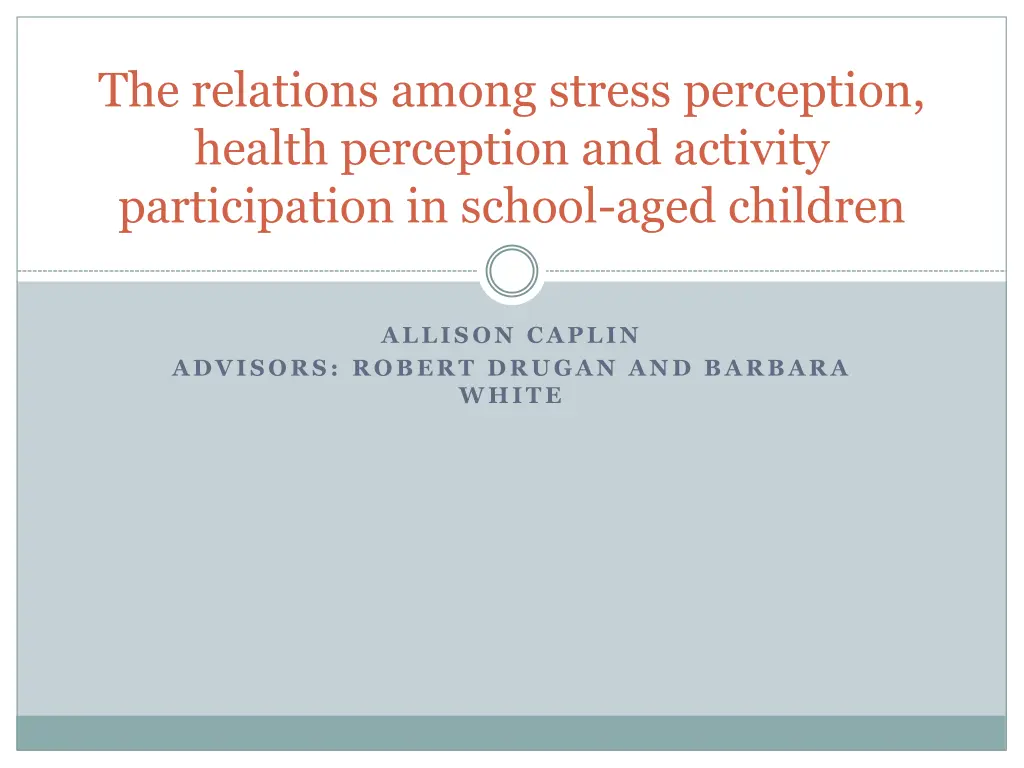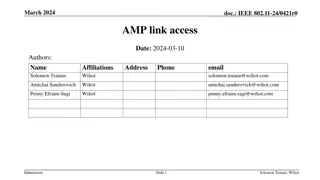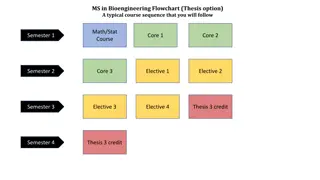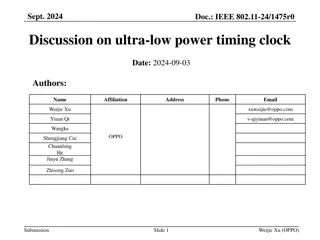
Understanding the Relationships Among Stress, Health, and Activity in School-Aged Children
Explore the connections between stress perception, health perception, and activity participation in school-aged children through a correlational study. Discover how stress affects daily life activities and occupations, and the impact of controllability on coping strategies. Investigate the role of physical activity and social support in managing stress in children.
Uploaded on | 0 Views
Download Presentation

Please find below an Image/Link to download the presentation.
The content on the website is provided AS IS for your information and personal use only. It may not be sold, licensed, or shared on other websites without obtaining consent from the author. If you encounter any issues during the download, it is possible that the publisher has removed the file from their server.
You are allowed to download the files provided on this website for personal or commercial use, subject to the condition that they are used lawfully. All files are the property of their respective owners.
The content on the website is provided AS IS for your information and personal use only. It may not be sold, licensed, or shared on other websites without obtaining consent from the author.
E N D
Presentation Transcript
The relations among stress perception, health perception and activity participation in school-aged children ALLISON CAPLIN ADVISORS: ROBERT DRUGAN AND BARBARA WHITE
PURPOSE A correlational study using quantitative data that will analyze the possible relations among children s activity patterns, perceived stress, and perceived health. Hypothesis: There will be significant relations among stress perception and reported daily life activities/occupations There is insufficient literature to support a directional hypothesis about these relations
STRESS Stress: a physical, chemical, or emotional factor that causes bodily or mental tension and may be a factor in disease causation Everyday hassles that affect most adolescents can be a source of considerable stress [Seiffge-Krenke, 1995] Research supports the negative impact of stress on health [McEwen & Lasely, 2002; Sapolsky, 2004] Psychosocial stress increases susceptibility to upper respiratory disease [Cohen et al., 1998] In children, stress can affect brain and immune function development causing vulnerability to later life stressors and their negative health effects [Middlebrooks & Audage, 2008]
ACTIVITY PARTICIPATION Under high stress conditions we only engage in those activities critical to sustain daily life [Wilcock, 1998] Physical activity is a stress reducer in children [McBride and Midford, 1999] Engaging in physical activities helps to produce a calming feeling in children [Kostenius, C., & hrling, K. 2009] Social support helps children cope with stress [Cutrona, 1990]
Control as a mediating factor? When stressors are perceived as controllable, coping ability is increased. This leads to lower stress and lower rates of depression. [Bandura , 1977, 2006] Overinvolved and over controlling parenting is associated with anxiety and anxiety disorders in youth. [Ginsburg, Siqueland, Masia-Warner, &Hedtke, 2004] Problem-to-emotion-focused coping relates to lower levels of distress for controllable events, whereas the opposite is true for low control events [Forsythe & Compas, 1987]
Method THIS STUDY IS DESIGNED TO EXTEND UNH S STUDY CHILDREN S HEALTH, STRESS AND OCCUPATIONS, UNH IRB #3807 BY GATHERING INFORMATION REGARDING THE PERCEPTION OF STRESS IN CHILDREN BASED ON DATA FROM A NEWLY PUBLISHED AND PSYCHOMETRICALLY TESTED TOOL.
Participants Thirty three children (18 male, 15 female) Ages 5-15 years old M=9.55 years old Recruitment: Existing relationships with family, family friends, and childcare facilities Snowball sampling procedure to generate new participants Summer camp programs
Procedure IRB approval Obtain parental consent and child assent Demographic Sheet to be completed by parent Conduct 30-45 minute sessions to administer three tools designed to capture: Perceived health Activity participation Perceived stress
Measures PERCEIVED HEALTH QUESTIONNAIRE PEDIATRIC ACTIVITY CARD SORT CHILDHOOD STRESS QUESTIONNAIRE
Perceived Health Perceived Health Questionnaire Created for use in UNH IRB #3807 (unpublished) 8 questions regarding general level of health and well being Approximately 5 minutes to complete How often in the past few weeks have you had a cold? ___ Never ___ 1 time ___ More than 2 times Which one describes how healthy you feel?
Activity Participation Pediatric Activity Card Sort (PACS) Occupation-based, pediatric self-report assessment tool Contains cards with pictures of daily activities and asks children to report how often they engage in each 90 cards/activities (personal care, school/productivity, hobbies/social activities, sports) Approximately 15 minutes to complete
Perceived Stress Childhood Stress Questionnaire (CSQ) A new tool (2011) designed and analyzed psychometrically by Dr. Byrne of The Australian National University Contains 50 questions that identify stressors that may or may not have happened in the past year Everyday hassles beyond normal control Parental relationships Periods of transition and change School based problems Family upheaval Approximately 15 minutes to complete
Control After school and on weekends I get to choose most of the things that I do. Yes No On most days I am happy. Yes No
Analyses DESCRIPTIVE STATISTICS FOR DEMOGRAPHIC DATA SPEARMAN S R CORRELATIONS FOR RELATIONS BETWEEN STRESS, HEALTH, OCCUPATIONS WITH CONTROL AS A POSSIBLE MEDIATING FACTOR CHI SQUARE CROSSTABULATIONS TO DETERMINE LIKELIHOODS FOR TRENDS IN DATA
Sample Descriptives 94% white/Caucasian 82% of mothers received a college degree 76% of fathers received a college degree 88% middle to upper-middle range family incomes 76% combined income $100,000+ 12.2% combined income $75,000-$99,999 58% live with both parents 30.3% divorced parents
Unexpected Findings No correlation between number of activities reported and stress level No correlation between perception of control and reported stress level We elected to create variables with a higher and lower condition for stress, age and control to observe likelihoods with Chi Square testing There was a likelihood to report lower levels of stress with higher levels of control There was a likelihood to report lower levels of stress with age highlowstress * highlowcontrol Crosstabulation Count control Total high low low 12 4 16 stress high 3 14 17 Total 15 18 33 highlowstress * youngerolder Crosstabulation Count age Total younger older low 5 11 16 stress high 11 6 17 Total 16 17 33
Discussion WEAKNESSES AND IMPLICATIONS FOR FUTURE RESEARCH
Weaknesses Modest sample size Lack of diversity within the sample Large range of ages Siblings Relationship to me Dispersion of CSQ was not normal more kids reported lower stress patterns than would be expected
Implications This study attempted to fill a gap in the literature for child specific research Our results indicate that there may be specific patterns for Caucasian children with middle to high socioeconomic status that is in stark contrast to the pre- existing research on stress and control CSQ- Has not been used in any other studies to my knowledge Do not know what the normal scoring is on the measures Although it looked like kids scored very low, maybe this is normal Children s ability to accurately self-report The actual answer may be less relevant than their perceived answer In future research- larger number of same age children
This research was funded by Mr. Dana Hamel through the Hamel Center for Undergraduate Research EDUCATION WITH A DIFFERENCE HOOD HOUSE 209, 603.862.4323 WWW.UNH.EDU/UNDERGRAD-RESEARCH
Special Thanks To.. Rob and Barb David and Matt My parents






















